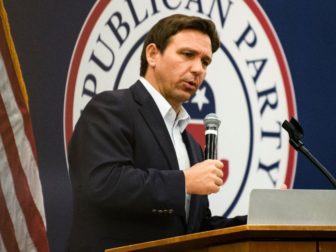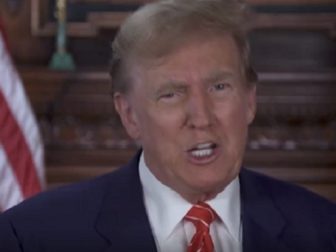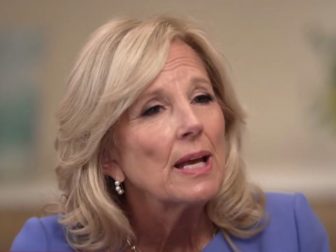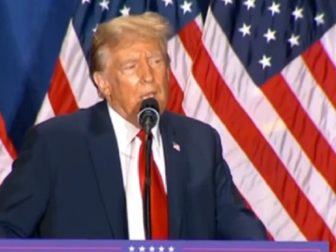Trump's Stance on Abortion Follows the Example Lincoln Set with Abolition
Former President Donald Trump has faced harsh criticism regarding his abortion stance similar to what Abraham Lincoln experienced when abolitionists felt he was moving too slowly to end slavery.
In Monday’s remarks regarding abortion, Trump noted that thanks to his appointment of three constitutionally conservative justices, the Supreme Court overturned Roe v. Wade in June 2022.
“My view is now that we have abortion where everybody wanted it from a legal standpoint, the states will determine by vote or legislation, or perhaps both, and whatever they decide must be the law of the land,” the 45th president said.
“Many states will be different,” he continued. “Many will have a different number of weeks, or some will have more conservative than others, and that’s what they will be. At the end of the day, this is all about the will of the people.
“Now, it’s up to the states to do the right thing,” Trump said. “You must follow your heart on this issue, but remember, you must also win elections to restore our culture, and in fact to save our country, which is currently and very sadly a nation in decline …We have to bring our nation back from the brink … and we will.”
So Trump sees his paramount objective is to save the country from the place President Joe Biden and the Democrats have taken it, both domestically and on the international stage.
BREAKING: Donald Trump’s full statement on abortion. pic.twitter.com/2Am7G9QK3f
— LifeNews.com (@LifeNewsHQ) April 8, 2024
When the New York businessman first ran for president in 2016, he did not pledge to end abortion, much as Lincoln did not promise to abolish slavery.
[firefly_poll]
Rather, Trump pledged to appoint conservative, pro-life judges to the Supreme Court.
During a presidential debate with Democratic nominee Hillary Clinton, moderator Chris Wallace asked the then-GOP nominee, “Do you want to see the court overturn Roe v. Wade?”
“Well, if we put another two or perhaps three justices on [the Supreme Court], that’s really what’s going to be — that will happen,” Trump answered.
“And that will happen automatically, in my opinion, because I am putting pro-life justices on the court,” he added.
“I will say this: It will go back to the states, and the states will then make a determination,” Trump observed, and that is what happened in June 2022.
When Lincoln ran as the Republican nominee for president in 1860, his party’s platform called for preventing the growth of slavery into the western territories.
During the course of the Civil War, Lincoln and Congress would eventually take action to end slavery, but they, and likely the majority of Americans, were not there yet politically in the spring of 1861 when the 16th president took office.
Along the way to his reaching that decision, abolitionists like former slave Frederick Douglass, William Lloyd Garrison and Horace Greeley would become exasperated with Lincoln.
“Our faith in him was often taxed and strained to the uttermost,” Douglass later recalled.
Garrison, publisher of “The Liberator,” wrote in a letter after Lincoln’s address to Congress in December 1861, “What a wishy-washy message from the President! …. [H]e seems incapable of uttering a humane or generous sentiment respecting the enslaved millions in our land.”
New York Tribune editor Horace Greeley published an open letter to Lincoln in his paper in August 1862, titled “The Prayer of the Twenty Millions.” In it, he argued that even if the rebellion were “crushed out tomorrow, [it] would be renewed within a year if Slavery were left in full vigor,” because the existence of the institution was the “inciting cause” of the war.
Lincoln responded in a letter to Greeley three days later, writing that his preeminent goal was to “save the Union.”
He further explained that he didn’t side with those who said the only way he could do that was to keep slavery. He also didn’t agree with those who said he must completely destroy slavery to save the Union. Rather, he would follow the course he believed would save the United States and end the war the quickest, whether it meant freeing all the slaves, some of them, or none of them at all.
“I have here stated my purpose according to my view of official duty; and I intend no modification of my oft-expressed personal wish that all men every where could be free,” Lincoln concluded. He had spoken eloquently on the issue during his debates with Illinois U.S. Sen. Stephen Douglas in 1858, and in his Cooper Union Address in 1860.
In September 1862, just weeks after Lincoln’s letter to Greeley and the Union Army’s victory at the Battle of Antietam, Lincoln issued his Emancipation Proclamation, freeing all the slaves in states then in rebellion against the United States.
Some border slave states — Delaware, Maryland, Kentucky and Missouri — had stayed in the Union, and the Proclamation did not impact them. In other words, Lincoln’s move was to free some, but not all the slaves.
Regarding the Proclamation, Garrison penned in a letter to his wife, “What was wanted, what is still needed, is a proclamation, distinctly announcing the total abolition of slavery. The President can do nothing for freedom in a direct manner, but only by circumlocution [evasive language] and delay!”
Finally, in January 1865, near the end of Lincoln’s first term, Congress passed the 13th Amendment ending slavery, with the president’s full support.
During his first term, Trump, like Lincoln, took action through the appointment of conservative justices, thereby setting in motion the overturning of Roe, which means many more — but not all — of the unborn are being protected by law.
And he has his own Garrisons and Douglasses — like former Vice President Mike Pence and pro-life advocates Abby Johnson and Lila Rose — denouncing him for not taking a stand to end all abortions through federal legislation, but the country is not there yet, politically.
Even if he promised to sign a 15-week ban, the Republicans would need a filibuster-proof pro-life majority (60 votes) and to retain the House with a majority that supports that position.
GOP Sens. Lisa Murkowski of Alaska and Susan Collins of Maine support Roe.
President Trump’s retreat on the Right to Life is a slap in the face to the millions of pro-life Americans who voted for him in 2016 and 2020. By nominating and standing by the confirmation of conservative justices, the Trump-Pence Administration helped send Roe v. Wade to the…
— Mike Pence (@Mike_Pence) April 8, 2024
Polling shows most Americans oppose abortions after the first trimester of the pregnancy, which gives some hope such legislation may be possible down the road.
Gallup found last summer that a majority believe abortions should be illegal in the second trimester (55 percent) and third (70 percent).
However, 69 percent still want it legal in the first trimester (conception to 14 weeks).
Candidates and elected leaders cannot go much further than where voters are on a major issue and hope to win or stay in office.
The pro-life cause will likely be greatly set back if Trump loses in November.
What if Lincoln had not won a second term, and the Democrat candidate prevailed in the election of 1864 on his party’s platform of a negotiated peace and no abolition of slavery?
The cause of emancipation would likely have been set back decades.
If Democrats win the presidency, a filibuster-proof majority in the Senate and retake the House in November, they will, at a bare minimum, pass federal legislation making Roe v. Wade the law of the land.
Then most, if not all the good work done at the state level to protect life since the overturning of Roe will go away.
Trump has taken the position that gives him and Republicans the chance to win in November.
Meanwhile, pro-life advocates in the states can continue to work to change hearts and minds on the issue and preserve more lives.
This article appeared originally on The Western Journal.











